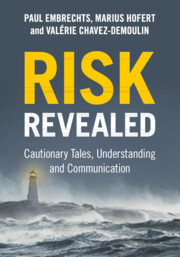Book contents
- Frontmatter
- Dedication
- Contents
- Preface
- Introduction
- 1 The 1953 Great Flood
- 2 The Space Shuttle Challenger Disaster
- 3 The 2007–2008 Financial Crisis
- 4 Earthquakes and Tsunamis
- 5 The L’Aquila Trial and the Public Communication of Risk
- 6 The Coronavirus Pandemic
- 7 Mathematical Wonderland
- 8 Stochastic Modeling
- 9 The Modeling of Extreme Events
- 10 On Climate Change and Related Risk
- 11 Further Examples from the World of Extremes
- 12 Networks
- 13 The Black Tulip and February 3, 1637
- A Note About the References
- References
- Index
4 - Earthquakes and Tsunamis
Published online by Cambridge University Press: 05 April 2024
- Frontmatter
- Dedication
- Contents
- Preface
- Introduction
- 1 The 1953 Great Flood
- 2 The Space Shuttle Challenger Disaster
- 3 The 2007–2008 Financial Crisis
- 4 Earthquakes and Tsunamis
- 5 The L’Aquila Trial and the Public Communication of Risk
- 6 The Coronavirus Pandemic
- 7 Mathematical Wonderland
- 8 Stochastic Modeling
- 9 The Modeling of Extreme Events
- 10 On Climate Change and Related Risk
- 11 Further Examples from the World of Extremes
- 12 Networks
- 13 The Black Tulip and February 3, 1637
- A Note About the References
- References
- Index
Summary
When it comes to natural disasters, earthquakes and tsunamis all too often top the list of worst calamities. Using several examples we will try to improve our understanding of how they occur. In later chapters, we discuss whether science indeed has techniques that can lead to statistical modeling. The examples discussed include the 2004 Boxing Day tsunami, killing more than 220 000 people, the 2011 Tōhoku earthquake and tsunami, which included the major nuclear disaster in Fukushima, and the volcanic explosion at the kingdom of Tonga on January 15, 2022. From each of these events we discuss specifics concerning risk, both in understanding as well as communication. We start the chapter with a brief, non-technical discussion of (Daniel) Bernoulli’s principle in incompressible fluids. This allows us to learn how tsunamis are formed and propagate across oceans causing catastrophic inundations to lower-lying coastal areas, often very far away. Especially for the Tōhoku and Fukushima case, we discuss the crucial difference between an "if" approach to risk management versus a "what if" one. The Tonga explosion highlights the importance of modeling such extremal events, taking the global geometric shape of our planet into account.
Keywords
- Type
- Chapter
- Information
- Risk RevealedCautionary Tales, Understanding and Communication, pp. 43 - 56Publisher: Cambridge University PressPrint publication year: 2024



